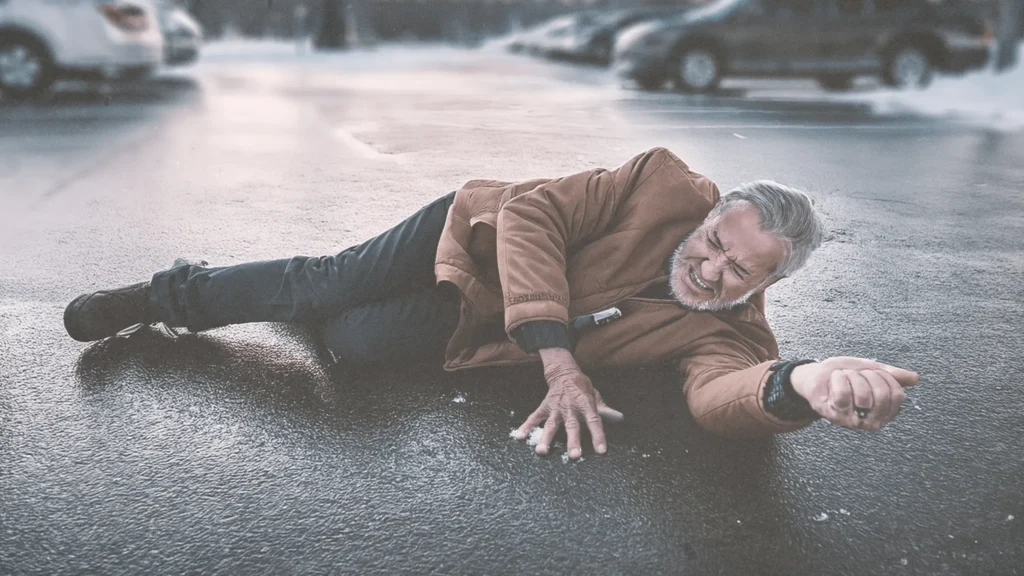Black ice is a significant hazard, especially in commercial properties and parking lots. This nearly invisible layer of ice can form even with minimal precipitation, making it a stealthy danger for both drivers and pedestrians. Let's explore the formation, risks, and statistics related to black ice, particularly in commercial settings.

Black ice is a thin, transparent layer of ice that forms on roadways, sidewalks, and parking lots. It gets its name because it blends in with the pavement, making it nearly invisible and extremely dangerous. Unlike regular ice, black ice is clear and smooth, which means it doesn't have the white, frosty appearance that makes other ice patches more noticeable.
Black ice can form in several ways:
In commercial properties, parking lots and walkways are particularly vulnerable to black ice. These areas are often shaded and can retain moisture, making them prime spots for black ice formation. Effective ice management is crucial in these areas to prevent slip and fall accidents, which are common and can lead to serious injuries such as fractures, sprains, and head injuries.
Black ice is a major cause of vehicle accidents in parking lots. Drivers may not realize they are driving on ice until it's too late, leading to loss of control and collisions. These accidents can cause significant property damage and personal injury.
According to the Federal Highway Administration (FHWA), over 1,300 people are killed and more than 116,800 are injured annually due to icy pavement. Black ice is a significant contributor to these statistics, as it is often difficult to detect and can cause sudden loss of vehicle control.
Slip and fall accidents on ice are also a major concern. Each year, around 1 million Americans are injured due to slip and fall accidents, with the risk increasing dramatically during the winter months. Effective ice management is essential to reduce these risks. In 2014, there were 42,480 workplace injuries or illnesses from ice, sleet, or snow that required at least one day off work.
Accidents caused by black ice can lead to significant direct costs for commercial property owners. Poor ice management can exacerbate these costs, which include medical expenses for injured individuals, legal fees from potential lawsuits, and increased insurance premiums. For example, a single slip and fall accident can result in medical bills exceeding $30,000, not to mention potential legal settlements that can reach into the hundreds of thousands of dollars.
Indirect costs can also be substantial. These include lost productivity due to employee injuries, damage to the property’s reputation, and potential loss of business if customers perceive the property as unsafe. Additionally, the time and resources spent on dealing with accidents and their aftermath can divert attention from other important business operations.
A commercial property in Minnesota experienced a significant increase in slip and fall accidents during the winter months. Despite regular snow removal, black ice continued to form in shaded areas of the parking lot. After implementing a more rigorous ice management schedule and installing warning signs, the property saw a 50% reduction in accidents over the next winter season.
A retail store in New York faced multiple lawsuits due to slip and fall accidents caused by black ice in their parking lot. The store management decided to invest in heated pavement technology, which helped to prevent ice formation altogether. This proactive ice management investment not only reduced accidents but also improved customer satisfaction and safety.
Black ice is particularly dangerous because it is almost invisible. Drivers and pedestrians often do not realize they are on ice until it is too late. The smooth, clear nature of black ice means it lacks the rough texture that provides traction, making it extremely slippery.
Black ice typically forms under specific weather conditions:
Commercial property owners have a legal obligation to maintain safe conditions for their customers and employees. Failure to address black ice hazards can result in liability for accidents. Property owners can be held responsible for medical expenses, lost wages, and other damages resulting from slip and fall accidents.
To protect themselves legally, property owners should:
Black ice is a hidden danger that can cause serious accidents in commercial properties and parking lots. By understanding how black ice forms and implementing proactive ice management measures to prevent it, property owners can reduce the risk of accidents and keep their premises safe. Remember, even a small amount of moisture can lead to the formation of black ice, so vigilance is key.
For more detailed statistics and resources on black ice accidents, you can refer to the Federal Highway Administration and other safety organizations.